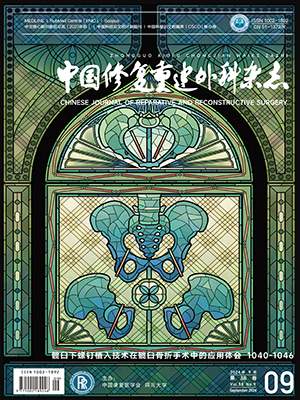Objective To investigate the outcome of repairing hand composite defects using pedicle osteocutaneous groin flap. Methods From February 1998 to May 2004, 33 cases of hand composite defects were repaired with pedicle osteocutaneous groin flap. There were 22 males and 11 females. The age was 19 to 54 years with an average of 243 years. The defect was caused by palmar penetrating injury in 17 cases, by dorsal hand crushing injury in 9 cases and by other injury in 7 cases. Twentythree cases complicated by metacarpal defect, 10 by phalanx defect. Thesize of skin defect was 3.5 cm×2.0 cm to 15.0 cm×10.0 cm, the size of bonedefect was 1.5 to 3.5 cm. After 3 to 7 days of primary debridement, defect was repaired by the pedicle osteocutaneous groin flap based on the superficial circumflex iliac vessels. The flap size was 4.0 cm×2.5 cm to 17.0 cm×11.0 cm. Results All the osteocutaneous flaps survived. During the 4 to 22 months follow-up postoperatively, thetexture, appearance and function of the flap were excellent and bone union was obtained in all cases after 7 to 9 weeks of operation.Conclusion The pedicle osteocutaneous groin flap is an ideal flap to repair the composite defect of the hand, with the benefit of simple procedure and reliable blood supply.
Citation: WANG Xin,CHEN Hong,ZHANG Weiwen,et al.. REPAIR OF COMPOUND SKIN AND BONE DEFECTS IN HANDS WITH PEDICLE OSTEOCUTANEOUS GROIN FLAP BASED ON SUPERFICIAL CIRCUMFLEX ILIAC VESSELS. Chinese Journal of Reparative and Reconstructive Surgery, 2006, 20(5): 547-549. doi: Copy




